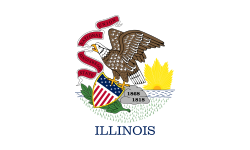Illinoisterritoriet
| Illinoisterritoriet | ||||
| Illinois Territory (Engelska) | ||||
| ||||
| Huvudstad | Kaskaskia | |||
| Språk | engelska | |||
| Religion | protestantisk kristendom | |||
| Bildades | 1809 | |||
| – bildades genom | lagstiftning | |||
| – bildades ur | Indianaterrioriet | |||
| Upphörde | 1818 | |||
| – upphörde genom | delning | |||
Illinoisterritoriet (engelska: Illinois Territory) var ett amerikanskt territorium, som existerade från 1 mars 1809 till 3 december 1818[1], då de södra delarna uppgick i den amerikanska delstaten Illinois, medan de norra tillfördes Michiganterritoriet.
Tidigare tillhörighet
Området hade tidigare kallats Illinois Country under de franska åren, först som del av Franska Kanada och sedan som del av Franska Louisiana . Britterna fick makten över området 1763 genom Parisfreden, som innebar slutet på Fransk-indianska kriget. Under Amerikanska självständighetskriget, tog George Rogers Clark kontroll över området för Virginias räkning, vilket ledde till att Illinois blev ett county i Virginia. Staten gav senare upp alla territoriella anspråk norr om Ohiofloden till USA:s federala statsmakt, för att tillfredsställa kustlösa delstater.
Tillkomst
Sedan området avträtts av Virginia tillhörde det Nordvästterritoriet (från 13 juli 1787 till 4 juli 1800), och sedan Indianaterritoriet, medan Ohio förberedde sig för att bli delstat. Den 3 februari 1809 godkände USA:s kongress lagen som skapade Illinoisterritoriet.
Källor
- Den här artikeln är helt eller delvis baserad på material från engelskspråkiga Wikipedia, 25 april 2013.
Fotnoter
- ^ ”Illinois” (på engelska). World Statesmen. http://www.worldstatesmen.org/US_states_F-K.html#Illinois. Läst 20 juli 2015.
Media som används på denna webbplats
US Flag with 21 stars. In use 4 July 1819–3 July 1820. Created by jacobolus using Adobe Illustrator, and released into the public domain.
Digital reproduction of the Star Spangled Banner Flag, the 15-star and 15-stripe U.S. garrison flag which flew over Fort McHenry following the Battle of Baltimore in the War of 1812. Seeing the flag during the battle, and again the following morning, inspired Francis Scott Key's song The Star-Spangled Banner, now the U.S. national anthem. During the battle a smaller "storm flag" was flown; it was replaced by this larger flag early the next morning, which is the flag Key saw then. This larger flag is now displayed at the National Museum of American History in Washington, D.C. For several decades it remained in the family of Fort McHenry's commanding officer, before being given to the Smithsonian in 1912. The family cut pieces out of the flag from time to time as gifts.
The original flag was 42 feet long and 30 feet high, with each stripe being about two feet, and the stars being about two feet in diameter. It was made by Mary Young Pickersgill and her assistants. More info on the original dimensions here. The stars seem to mostly point to the side, except for one (the bottom right) which points down. One star has been cut out of the actual flag, so I'm guessing that originally pointed to the side as well (Fort McHenry flies a flag (File:Ft mchenry 15starflag.jpg) with a similar star pattern, but it looks like they are all to the side, and the other dimensions look similar to a modern flag). I guesstimated other dimensions and star positions based on File:Star-Spangled-Banner-1908-1919.jpg; the union (blue area) looks to be about 19 feet wide. The star rows look to be evenly distributed; i.e. the distance between the top/bottom edges and the center of a star row looks to be about the same as the distance between two (centers of) rows. Not so left-to-right; they are pretty close to the right edge and even closer to the hoist side. Also available here, page 12.


